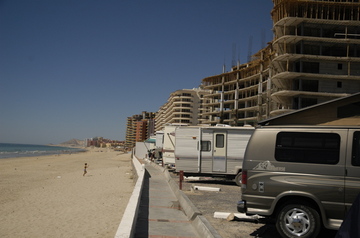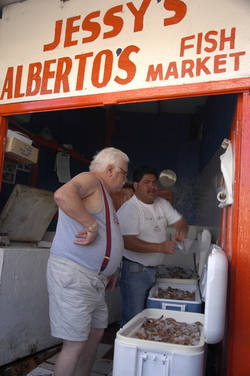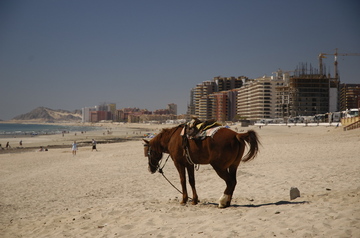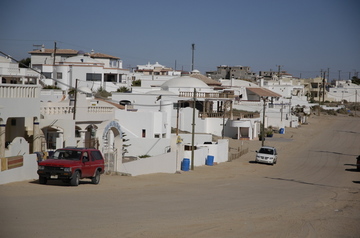The scourge of Puerto Peñasco is condominium development. The north shore, called “Sandy Beach” is being completely covered by high-rise buildings, each offering a more “luxurious” living experience than the next. You can see the billboards along Rt 8 as you drive into town. These developments are primarily for Americans, and each one has a Sales Office, a gang of real estate agents, and a model home NOW OPEN, just like US condo developments.

Condos going up along Sandy Beach. Click for extra large view.
The pace of real estate development in Mexico is quite a bit slower than in the US, and apparently hazardous. All over town there are remnants of projects begun but not finished. Skeletons of steel framework, foundations poured over sand, lots cleared of their original modest structures but now accumulating only garbage, tattered and faded signs promising exciting new homes “coming soon” “¦ all of these things suggest a boom-or-bust mentality, and to the skeptical real estate investor they spell Buyer Beware. It would be very dangerous to take advantage of “Pre-construction pricing”, given that the construction phase might never be completed. A few people that Ken & Petey have talked to are caught in exactly that bind. Their condominium is three years behind schedule. Mañana “¦
Still, at least half a dozen major projects are underway on Sandy Beach, and several are already open. Nearby is Playa Bonita RV park, one of the nicest in town, similar to Playa de Oro but facing a nicer stretch of beach and some frankly beautiful views.

Front row at Playa Bonita RV Park
I’d stay in the park, but I can’t see buying one of the condo properties. As these developments go up, they emphasize the boundary between the “haves” and the “have nots”. The road to the resorts may be gated, paved, and lined with palm trees just like in Florida, but just a block to either side the streets are still made of sand, lined with roofless shacks, trash, mongrel dogs, and other indicators of a poor people. It’s a startling disparity of wealth that is sealing off miles of their beach for the exclusive use of Norteamericanos.
Google Earth location of Sandy Beach.
To the south of town, along Los Conchos Beach, development has taken the form of miles of single-family residences clustered along a narrow strip of coastline. Driving through this area is almost surreal because of the strange architectural styles. Most of the houses have a “Mediterranean” influence, but odd visual cues are everywhere. One house brags both Roman columns and Russian minarets. Others are a hodge-podge of Greek, Spanish, and Turkish styles.
The entire neighborhood is accessible only by hard-packed sand streets, and since most of the houses are rentals or “fractionals” (a form of timeshare ownership), the neighborhood is transient and sterile. But for a pure getaway, just to hang with the family and play on the beach, it looks good. The view to the calm blue water of the Sea of Cortez is admittedly beautiful.
Google Earth location of Los Conchos Beach area.
Do we feel safe? Yes, we do. There’s much more to be concerned about, crime-wise, in New Orleans, Miami, or even tiny Ajo, Arizona. This is not a border town, and the drug problems that go with borders seem to have bypassed Puerto Peñasco. The beach is lightly populated with families playing games on the sand, and college students admiring each other from beach towels. The RV park is full of happy Americans walking around in towels, and not one sign of a criminal element has appeared. We are much more comfortable here than we would be camping in many US downtowns.
The worst problem seems to be badly inebriated college students. Puerto Peñasco apparently wants to reach the Ft. Walton/Destin standard of Spring Break, and the town is getting there. Billboards and signs on the restaurant/BARs advertise to their prurient interests (binge drinking and wet t-shirt contests), and so from late afternoon onward it’s not hard to find evidence of the unfortunate results. Yesterday Ken was favored with a view of a student vomiting next to a trailer here in the park, while the student’s friends offered unhelpful comments ( “Hey, you gonna be OK, man?”). One hopes that it was his own trailer he was tossing cookies on, and not one belonging to some poor visitor from Colorado.
There is a feeling of “anything goes” here, but it’s really not true. They do rent ATVs to college students and let them roar through town on them, helmetless and belching, but the police are still visible where needed. At night the scene is probably horrific with crowds on the streets and various mating displays rivaling Mardi Gras in the French Quarter, but at that time we are back in the Airstream enjoying dinner while the cool sea breeze blows through our open windows.

Selling shrimp in the Old Port
The Old Port is the only part of the town that is reminiscent of a border town like Tijuana, Ciudad Juarez, or Nogales. There you’ll find the usual border town shops carrying pharmaceuticals, tacky t-shirts, pottery, and other trinkets. But even still, it is nicer than the border towns. The open-air pescaderia has beautiful shrimp, clams, and fish, and friendly but not aggressive hawkers selling them. We would have bought a bunch of seafood, but this morning I bought a pound of jumbo shrimp for $7 from a vendor who was driving through our RV park, like the fresh-water vendor.
So we’ll grill the shrimp tonight and then go buy something else fresh tomorrow. In fact, since US Customs doesn’t seem to be concerned about Mexican seafood, we may load up on shrimp to bring back to Tucson, on our last day here.



